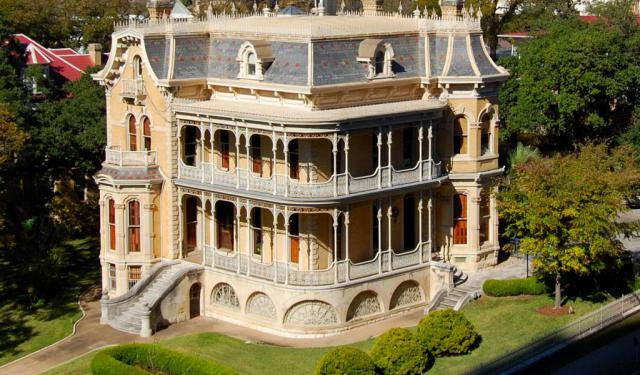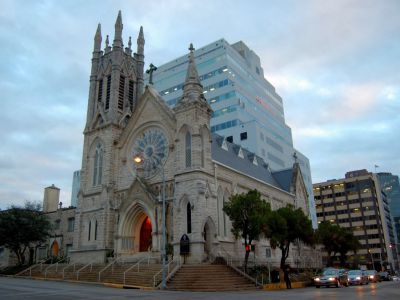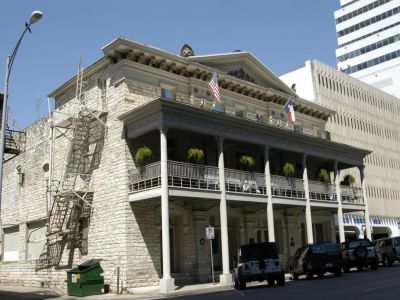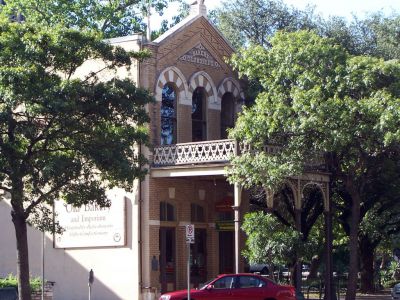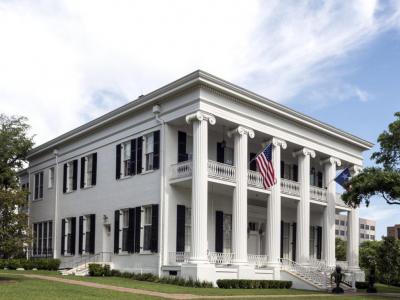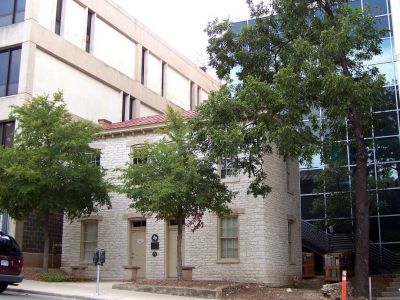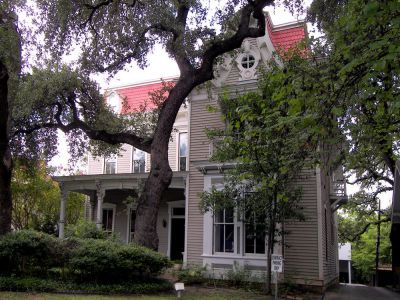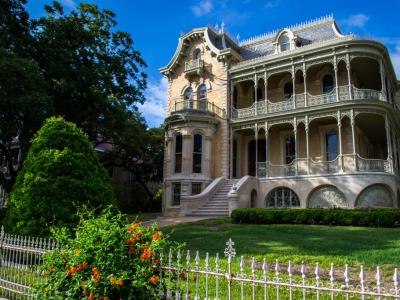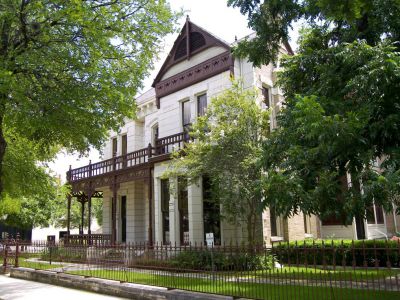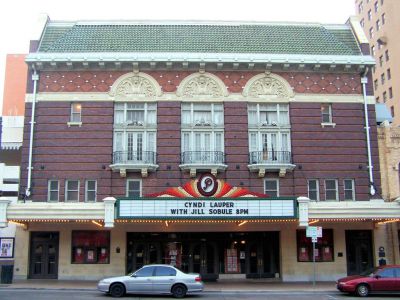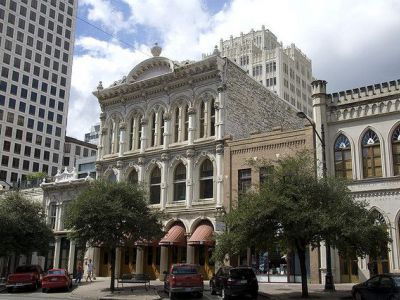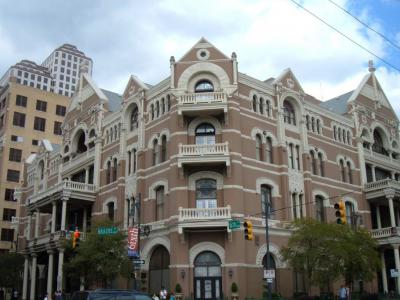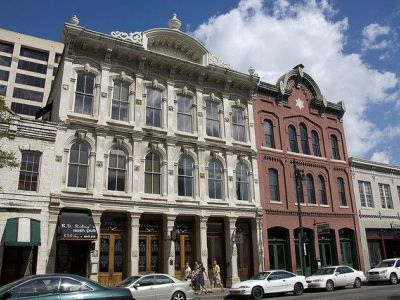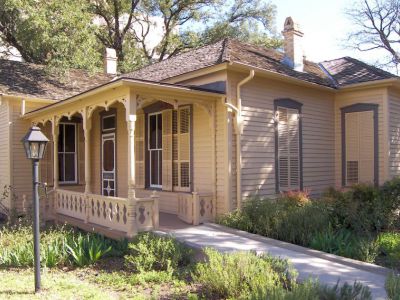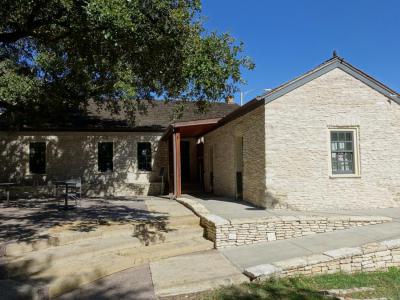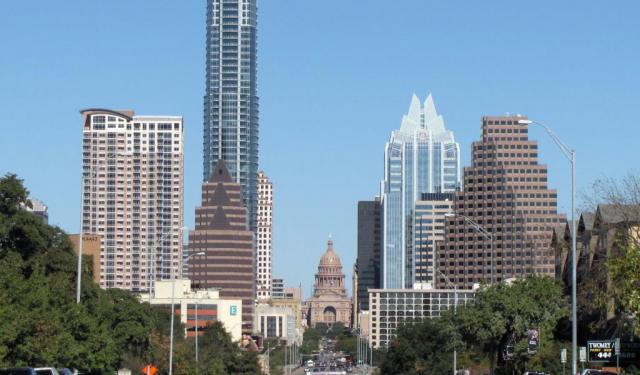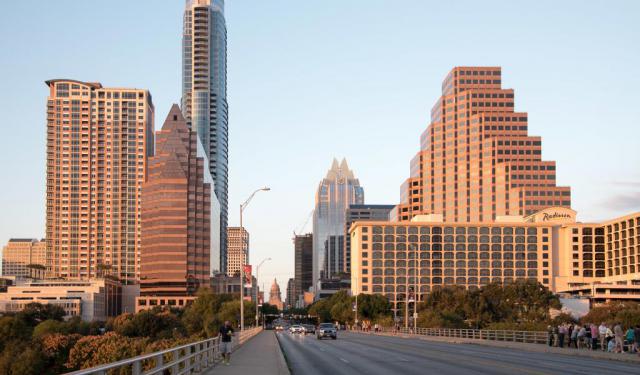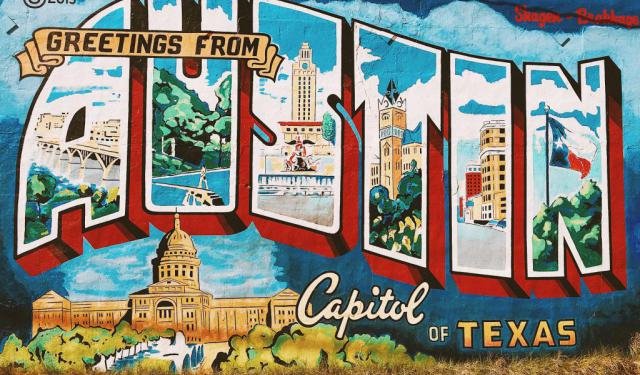Downtown Historical Buildings Walking Tour (Self Guided), Austin
Northwest downtown Austin boasts an impressive collection of historic residences of notable styles, ranging from classic Victorian to Georgian to Greek Revival. Carefully preserved and restored, these constructions – from nationally listed historic sites to the significant local elements of the built environment – form a major part of Austin’s cultural heritage and indelible chapter of its story.
Among the notable buildings found along Congress Avenue there are several true icons, like the Lundberg Bakery – one of the city’s largest and most successful bakeries (now housing an art gallery), established in 1876 by the Swedish immigrant Charles Lundberg, and the ornate Walter Tips Building of the same year – a three-story masterful blend of Venetian Gothic and Italianate Renaissance Revival styles.
Some other gems that the history and architecture buffs shouldn't miss, while in Austin, include:
Texas Governor's Mansion – the elegant edifice serving as the official residence of Texas governors and their families since 1856;
Paramount Theatre – a century-old performance venue and movie theater located in the heart of downtown Austin;
Driskill Hotel – built in 1886 by the cattle baron, Jesse Driskill, as a frontier showplace; recently restored;
O. Henry Museum – a former residence of the famed short story writer, William Sydney Porter, popularly known by his pen-name, O. Henry;
Susanna Dickinson Museum – home of the only Anglo adult survivor of the Battle of the Alamo.
If you're keen on having a quiet and more peaceful stroll, as opposed to that on the crowded Congress Avenue, and explore a number of historically important houses and mansions of Austin, take this self-guided walking tour and enjoy yourself.
Among the notable buildings found along Congress Avenue there are several true icons, like the Lundberg Bakery – one of the city’s largest and most successful bakeries (now housing an art gallery), established in 1876 by the Swedish immigrant Charles Lundberg, and the ornate Walter Tips Building of the same year – a three-story masterful blend of Venetian Gothic and Italianate Renaissance Revival styles.
Some other gems that the history and architecture buffs shouldn't miss, while in Austin, include:
Texas Governor's Mansion – the elegant edifice serving as the official residence of Texas governors and their families since 1856;
Paramount Theatre – a century-old performance venue and movie theater located in the heart of downtown Austin;
Driskill Hotel – built in 1886 by the cattle baron, Jesse Driskill, as a frontier showplace; recently restored;
O. Henry Museum – a former residence of the famed short story writer, William Sydney Porter, popularly known by his pen-name, O. Henry;
Susanna Dickinson Museum – home of the only Anglo adult survivor of the Battle of the Alamo.
If you're keen on having a quiet and more peaceful stroll, as opposed to that on the crowded Congress Avenue, and explore a number of historically important houses and mansions of Austin, take this self-guided walking tour and enjoy yourself.
How it works: Download the app "GPSmyCity: Walks in 1K+ Cities" from Apple App Store or Google Play Store to your mobile phone or tablet. The app turns your mobile device into a personal tour guide and its built-in GPS navigation functions guide you from one tour stop to next. The app works offline, so no data plan is needed when traveling abroad.
Downtown Historical Buildings Walking Tour Map
Guide Name: Downtown Historical Buildings Walking Tour
Guide Location: USA » Austin (See other walking tours in Austin)
Guide Type: Self-guided Walking Tour (Sightseeing)
# of Attractions: 14
Tour Duration: 2 Hour(s)
Travel Distance: 3.4 Km or 2.1 Miles
Author: christine
Sight(s) Featured in This Guide:
Guide Location: USA » Austin (See other walking tours in Austin)
Guide Type: Self-guided Walking Tour (Sightseeing)
# of Attractions: 14
Tour Duration: 2 Hour(s)
Travel Distance: 3.4 Km or 2.1 Miles
Author: christine
Sight(s) Featured in This Guide:
- Cathedral of Saint Mary in Austin
- Millett Opera House
- Lundberg Bakery
- Texas Governor's Mansion
- Brizendine House
- Robinson-Macken House
- John Bremond House
- Henry Hirshfeld House and Cottage
- Paramount Theatre
- Walter Tips Building
- Driskill Hotel
- Hannig Row Building
- O. Henry Museum
- Susanna Dickinson Museum
1) Cathedral of Saint Mary in Austin (must see)
Saint Mary's serves as the main cathedral for the Roman Catholic Diocese of Austin. Its history dates back to the 1850s, when the Catholic community in Austin constructed a small stone church called Saint Patrick's at the intersection of 9th and Brazos streets. In 1866, the church was renamed Saint Mary's, and the parish decided to build a new church using masonry construction. In 1872, after Austin was designated as the permanent capital of Texas, the parish laid the cornerstone for a new church one block north of the original location.
The parish had already established the foundation in the shape of a basilica and had started erecting the walls, which were 5 feet (1.5 meters) high when architect Nicholas J. Clayton began designing their new church.
In 1948, when the Diocese of Austin was established, this church became the cathedral for the newly formed diocese. During that time, the church underwent renovations, including the removal of many neo-Gothic decorations. The neo-Gothic altars and altar rail were replaced with marble fixtures from the 20th century, and the baldachino was adorned with cactus and bluebonnet motifs, reminiscent of central Texas.
Why You Should Visit:
If you're an architecture buff, this comfortably welcoming and beautiful classic Cathedral boasts a great deal of historic artwork to observe in detail: gorgeous stained glass windows dedicated to saints from old Europe, and woodwork.
And if you're a devoted Catholic, they do Latin Rite masses here, too.
Tip:
If you attend a Sunday mass, you'll feel like you are at a prayerful and inspiring concert.
The parish had already established the foundation in the shape of a basilica and had started erecting the walls, which were 5 feet (1.5 meters) high when architect Nicholas J. Clayton began designing their new church.
In 1948, when the Diocese of Austin was established, this church became the cathedral for the newly formed diocese. During that time, the church underwent renovations, including the removal of many neo-Gothic decorations. The neo-Gothic altars and altar rail were replaced with marble fixtures from the 20th century, and the baldachino was adorned with cactus and bluebonnet motifs, reminiscent of central Texas.
Why You Should Visit:
If you're an architecture buff, this comfortably welcoming and beautiful classic Cathedral boasts a great deal of historic artwork to observe in detail: gorgeous stained glass windows dedicated to saints from old Europe, and woodwork.
And if you're a devoted Catholic, they do Latin Rite masses here, too.
Tip:
If you attend a Sunday mass, you'll feel like you are at a prayerful and inspiring concert.
2) Millett Opera House
The Millett Opera House in Austin has played a significant role in the city's cultural and architectural heritage. Built in 1878 by Charles Millett, a local lumber seller, the opera house was a grand and spacious venue that quickly became one of the largest performance spaces in the state of Texas at the time.
Designed by the accomplished architect Frederick Ruffini, the Millett Opera House boasted several remarkable features, including its capacity to accommodate 800 removable seats, sturdy 24-inch limestone walls, and the distinction of being the largest enclosed space in the entire state of Texas. Its strategic location just south of the Texas Capitol building and a few blocks from Congress Avenue made it a central and popular entertainment hub during the Victorian era.
The building itself underwent some modifications over the years, with a notable change being the replacement of the original second-story bracket-supported balcony with a two-story gallery. The juxtaposition of rough-cut stone against finely detailed pilasters, capitals, and cornices gave the opera house a distinctive and aesthetically appealing appearance.
Following a period of various uses, including housing a printing company, the Austin Club, a local private social club, took over the building in 1979 through a long-term lease arrangement. The Austin Club subsequently undertook significant renovations to the structure. While the original performance space was removed, a portion of the original hand-painted ceiling remains intact in one of the meeting rooms, serving as a reminder of the building's rich history and grandeur.
Notably, the Millett Opera House was recognized for its historical and architectural significance when it was added to the National Register of Historic Places in 1978. Today, the Millett Opera House, under the ownership of the Austin Club, stands as a testament to Austin's cultural heritage, preserving the memory of a bygone era when it was a premier venue for entertainment and culture in Texas.
Designed by the accomplished architect Frederick Ruffini, the Millett Opera House boasted several remarkable features, including its capacity to accommodate 800 removable seats, sturdy 24-inch limestone walls, and the distinction of being the largest enclosed space in the entire state of Texas. Its strategic location just south of the Texas Capitol building and a few blocks from Congress Avenue made it a central and popular entertainment hub during the Victorian era.
The building itself underwent some modifications over the years, with a notable change being the replacement of the original second-story bracket-supported balcony with a two-story gallery. The juxtaposition of rough-cut stone against finely detailed pilasters, capitals, and cornices gave the opera house a distinctive and aesthetically appealing appearance.
Following a period of various uses, including housing a printing company, the Austin Club, a local private social club, took over the building in 1979 through a long-term lease arrangement. The Austin Club subsequently undertook significant renovations to the structure. While the original performance space was removed, a portion of the original hand-painted ceiling remains intact in one of the meeting rooms, serving as a reminder of the building's rich history and grandeur.
Notably, the Millett Opera House was recognized for its historical and architectural significance when it was added to the National Register of Historic Places in 1978. Today, the Millett Opera House, under the ownership of the Austin Club, stands as a testament to Austin's cultural heritage, preserving the memory of a bygone era when it was a premier venue for entertainment and culture in Texas.
3) Lundberg Bakery
The Lundberg Bakery, also known as the Old Bakery and Emporium, is a historic site located in downtown Austin, which currently functions as a gift shop. This building was completed in the year 1876. During the early days of the bakery's operation, bread was not packaged or wrapped for sale. Instead, customers would wait in line with baskets lined with cloth to carry their freshly purchased bread.
The bakery continued its operation until its owner, Charles Lundberg, a Swedish immigrant, passed away in 1895. Subsequently, the building changed ownership multiple times until it was acquired and renovated by the Austin Heritage Society in 1962. In 1970, the bakery faced a threat of demolition when plans were made to construct a new building for the Texas Department of Transportation. Fortunately, its preservation was ensured when excavations next door revealed the foundations of the previous state capitol building. These foundations were then transformed into a historical plaza, and the bakery was spared.
Constructed primarily from limestone with a brick facade, the building boasts a prominent cast-iron eagle at the apex of its gabled roof, which overlooks Congress Avenue. Notably, it was added to the National Register of Historic Places on December 17, 1969.
The bakery continued its operation until its owner, Charles Lundberg, a Swedish immigrant, passed away in 1895. Subsequently, the building changed ownership multiple times until it was acquired and renovated by the Austin Heritage Society in 1962. In 1970, the bakery faced a threat of demolition when plans were made to construct a new building for the Texas Department of Transportation. Fortunately, its preservation was ensured when excavations next door revealed the foundations of the previous state capitol building. These foundations were then transformed into a historical plaza, and the bakery was spared.
Constructed primarily from limestone with a brick facade, the building boasts a prominent cast-iron eagle at the apex of its gabled roof, which overlooks Congress Avenue. Notably, it was added to the National Register of Historic Places on December 17, 1969.
4) Texas Governor's Mansion
The Texas Governor's Mansion in Austin stands as a significant historical landmark and a symbol of Texas's rich history. Designed by the notable architect Abner Cook, this Greek Revival structure was built in 1854 and has served as the residence for every Texas governor since 1856. The mansion's current residents are Governor Greg Abbott and First Lady Cecilia Phalen Abbott.
This mansion is not just a home but also a piece of living history, holding the title of the oldest continuously inhabited house in Texas and ranking as the fourth oldest governor's mansion in continuous use by a chief executive in the United States. In recognition of its historical value, it was designated as the first Texas historic landmark in 1962, added to the National Register of Historic Places in 1970, and declared a U.S. National Historic Landmark in 1974.
Originally, the mansion was 6,000 square feet with 11 rooms but without any bathrooms. However, a 1914 remodeling expanded it to 8,920 square feet, enhancing it to 25 rooms and seven bathrooms. This architectural gem occupies the center of a block, embraced by lush trees and gardens.
The mansion's stewardship saw a significant change in 1931 when, on the recommendation of former First Lady Mildred Paxton Moody, the Texas Legislature created the Board of Mansion Supervisors to manage its upkeep. This board was later dissolved in 1965, with its duties transferred to the Texas Commission on the Arts.
An incident in the mansion's history occurred on June 8, 2008, when it was gravely damaged by an arson fire, caused by a Molotov cocktail. Thankfully, the restoration was completed by 2012, allowing this historic building to continue serving as a symbol of Texas governance and pride.
This mansion is not just a home but also a piece of living history, holding the title of the oldest continuously inhabited house in Texas and ranking as the fourth oldest governor's mansion in continuous use by a chief executive in the United States. In recognition of its historical value, it was designated as the first Texas historic landmark in 1962, added to the National Register of Historic Places in 1970, and declared a U.S. National Historic Landmark in 1974.
Originally, the mansion was 6,000 square feet with 11 rooms but without any bathrooms. However, a 1914 remodeling expanded it to 8,920 square feet, enhancing it to 25 rooms and seven bathrooms. This architectural gem occupies the center of a block, embraced by lush trees and gardens.
The mansion's stewardship saw a significant change in 1931 when, on the recommendation of former First Lady Mildred Paxton Moody, the Texas Legislature created the Board of Mansion Supervisors to manage its upkeep. This board was later dissolved in 1965, with its duties transferred to the Texas Commission on the Arts.
An incident in the mansion's history occurred on June 8, 2008, when it was gravely damaged by an arson fire, caused by a Molotov cocktail. Thankfully, the restoration was completed by 2012, allowing this historic building to continue serving as a symbol of Texas governance and pride.
5) Brizendine House
The Brizendine House, a significant historic home situated in downtown Austin, stands as a testament to the architectural and social history of the late 19th century. Constructed around 1870, this house is located on 11th Street and is now neighbored by modern structures such as an annex to the Travis County Courthouse and the Blackwell/Thurman Criminal Justice Center.
This house was built by John R. Brizendine, a native of Kentucky who was a skilled carpenter, machinist, and miller. Born in 1829, Brizendine lived in this home until his death in 1914, marking it as a significant part of his legacy. The Brizendine House is a prime example of a simple vernacular rough ashlar house, reflecting the lifestyle of Austin's working middle-class families in the late 1800s. Its exterior proportions exhibit the influence of Victorian architecture, a popular style of the era.
The construction material, limestone, was a common choice for building during this period and contributes to the house's historic charm and durability. The Brizendine House's significance was formally recognized in 1974 when it was added to the National Register of Historic Places, ensuring its preservation as a piece of Austin's history.
After Brizendine's death, the house changed hands and was bought by Mrs. Elizabeth Gordon in 1928. It remained in her family until 1972, serving as a residential property for nearly a century. Today, the Brizendine House in Austin symbolizes the city's 19th-century working middle-class history amidst urban changes.
This house was built by John R. Brizendine, a native of Kentucky who was a skilled carpenter, machinist, and miller. Born in 1829, Brizendine lived in this home until his death in 1914, marking it as a significant part of his legacy. The Brizendine House is a prime example of a simple vernacular rough ashlar house, reflecting the lifestyle of Austin's working middle-class families in the late 1800s. Its exterior proportions exhibit the influence of Victorian architecture, a popular style of the era.
The construction material, limestone, was a common choice for building during this period and contributes to the house's historic charm and durability. The Brizendine House's significance was formally recognized in 1974 when it was added to the National Register of Historic Places, ensuring its preservation as a piece of Austin's history.
After Brizendine's death, the house changed hands and was bought by Mrs. Elizabeth Gordon in 1928. It remained in her family until 1972, serving as a residential property for nearly a century. Today, the Brizendine House in Austin symbolizes the city's 19th-century working middle-class history amidst urban changes.
6) Robinson-Macken House
The Robinson-Macken House, a historic residence nestled in west downtown Austin, stands as a testament to the architectural and community history of the city. Constructed in 1876, this home initially belonged to Elizabeth and John Robinson Sr. The house is architecturally significant for its embodiment of the Second Empire style, distinguished by its two-and-a-half-story structure and Italianate detailing, which were popular in the late 19th century.
One of the notable aspects of the Robinson-Macken House is its location within the original Austin town plan from 1839, laid out by Edwin Waller. Its proximity to the residence of the Bremond family, an influential local name, further enhances its historical significance. This connection is also architectural, as the house exhibits stylistic parallels with the nearby Bremond Block Historic District.
In terms of ownership, the house has a rich history. Eugene Robinson, the son of the original owners, acquired it in 1902 from other heirs of the Robinson family. Subsequently, in 1928, Joe and Bridget Macken purchased the home, and it stayed in their family until 1983. Both the Robinsons and the Mackens were prominent figures in Austin's community life. John Robinson and Joe Macken notably contributed to the city's development through their roles as chief of the volunteer fire department and city alderman.
Architecturally, the Robinson-Macken House is remarkable for its L-plan design and several unique features. These include projecting bay windows adorned with classical detailing, finely milled woodwork, elegant dormer windows, and a distinctive mansard roof. These elements not only exemplify the architectural tastes of the era but also contribute to the house's status as a vital piece of Austin's heritage.
One of the notable aspects of the Robinson-Macken House is its location within the original Austin town plan from 1839, laid out by Edwin Waller. Its proximity to the residence of the Bremond family, an influential local name, further enhances its historical significance. This connection is also architectural, as the house exhibits stylistic parallels with the nearby Bremond Block Historic District.
In terms of ownership, the house has a rich history. Eugene Robinson, the son of the original owners, acquired it in 1902 from other heirs of the Robinson family. Subsequently, in 1928, Joe and Bridget Macken purchased the home, and it stayed in their family until 1983. Both the Robinsons and the Mackens were prominent figures in Austin's community life. John Robinson and Joe Macken notably contributed to the city's development through their roles as chief of the volunteer fire department and city alderman.
Architecturally, the Robinson-Macken House is remarkable for its L-plan design and several unique features. These include projecting bay windows adorned with classical detailing, finely milled woodwork, elegant dormer windows, and a distinctive mansard roof. These elements not only exemplify the architectural tastes of the era but also contribute to the house's status as a vital piece of Austin's heritage.
7) John Bremond House
The John Bremond House is situated within the Bremond Block Historic District, which consists of a group of eleven historic homes located in downtown Austin. These homes were constructed between the 1850s and 1910.
The John Bremond House stands out as the grandest among the Bremond Block residences. Constructed in 1886 by George Fiegel, this building features an ornate cast-iron wraparound porch and balcony, as well as an eye-catching mansard roof. It has retained its original late 1800s appearance. Presently, the property is owned by the Texas Classroom Teachers Association.
The entire block was officially listed on the National Register of Historic Places in 1970 and is recognized as one of the few remaining well-preserved upper-class Victorian neighborhoods from the mid to late nineteenth century in Texas.
Six of these houses were either built or expanded to accommodate members of the Bremond family, particularly Eugene and John Bremond, who were prominent figures in the social, merchandising, and banking circles of late-nineteenth-century Austin. These historic homes are nestled within the square block bounded by West Seventh, West Eighth, Guadalupe, and San Antonio streets. Additionally, the district encompasses several houses located on the west side of San Antonio Street and the south side of West Seventh Street, with at least three of them having connections to the North family.
The John Bremond House stands out as the grandest among the Bremond Block residences. Constructed in 1886 by George Fiegel, this building features an ornate cast-iron wraparound porch and balcony, as well as an eye-catching mansard roof. It has retained its original late 1800s appearance. Presently, the property is owned by the Texas Classroom Teachers Association.
The entire block was officially listed on the National Register of Historic Places in 1970 and is recognized as one of the few remaining well-preserved upper-class Victorian neighborhoods from the mid to late nineteenth century in Texas.
Six of these houses were either built or expanded to accommodate members of the Bremond family, particularly Eugene and John Bremond, who were prominent figures in the social, merchandising, and banking circles of late-nineteenth-century Austin. These historic homes are nestled within the square block bounded by West Seventh, West Eighth, Guadalupe, and San Antonio streets. Additionally, the district encompasses several houses located on the west side of San Antonio Street and the south side of West Seventh Street, with at least three of them having connections to the North family.
8) Henry Hirshfeld House and Cottage
The Henry Hirshfeld House and Cottage are a pair of historic residences located in downtown Austin. These homes were originally occupied by the notable Hirshfeld family. Henry Hirshfeld (1834-1911), a native of Germany, was a prominent Austin merchant and a leader in the city’s Jewish community. The cottage, constructed in 1873, served as the residence for Henry and his wife Jennie until the larger house was completed in 1885. These buildings have been carefully preserved and currently serve as the Office of Governmental Relations for the Texas A&M University System. Both structures were collectively added to the National Register of Historic Places in 1973.
Designed and constructed by architect John Andrewartha, the Henry Hirshfeld House displays architectural elements influenced by Victorian and Eastlake styles. The exterior embellishments include a double gallery, a bay window, stained glass features, intricate woodwork, and detailed limestone accents. The two-story stick style carriage house was constructed shortly after the completion of the main residence.
In 1873, Henry Hirshfeld had a single-story stone cottage built for his family. This cottage includes a widow's walk on its roof and decorative jigsaw detailing on the porch. After the Hirshfeld family relocated to their new home on the adjacent east lot in 1888, the cottage was used as a rental property.
Designed and constructed by architect John Andrewartha, the Henry Hirshfeld House displays architectural elements influenced by Victorian and Eastlake styles. The exterior embellishments include a double gallery, a bay window, stained glass features, intricate woodwork, and detailed limestone accents. The two-story stick style carriage house was constructed shortly after the completion of the main residence.
In 1873, Henry Hirshfeld had a single-story stone cottage built for his family. This cottage includes a widow's walk on its roof and decorative jigsaw detailing on the porch. After the Hirshfeld family relocated to their new home on the adjacent east lot in 1888, the cottage was used as a rental property.
9) Paramount Theatre
The Paramount Theatre, situated in downtown Austin, is a historic venue that serves as both a live theater and cinema. Constructed in the Classical Revival architectural style in 1915, this establishment has a rich and lengthy history spanning over a century. During its existence, the Paramount has hosted a diverse range of performances, from vaudeville acts to the premieres of numerous films, including both silent movies and "talkies." Some notable film premieres at the theater include Batman in 1966 and Sin City in 2005, in addition to various music, dance, and Broadway productions.
Over the years, a plethora of legendary artists and performers have graced the Paramount's stage, including renowned figures like Houdini, the Marx Brothers, Helen Hayes, Orson Welles, Sarah Bernhardt, the Ziegfeld Follies, the Metropolitan Opera, Lillian Russell, and George M. Cohan. More contemporary favorites who have performed here include Billy Joel, Willie Nelson, Jerry Jeff Walker, Sarah Vaughan, and Mandy Patinkin.
In recognition of its historical significance, the Paramount Theatre was officially added to the National Register of Historic Places on June 23, 1976.
Over the years, a plethora of legendary artists and performers have graced the Paramount's stage, including renowned figures like Houdini, the Marx Brothers, Helen Hayes, Orson Welles, Sarah Bernhardt, the Ziegfeld Follies, the Metropolitan Opera, Lillian Russell, and George M. Cohan. More contemporary favorites who have performed here include Billy Joel, Willie Nelson, Jerry Jeff Walker, Sarah Vaughan, and Mandy Patinkin.
In recognition of its historical significance, the Paramount Theatre was officially added to the National Register of Historic Places on June 23, 1976.
10) Walter Tips Building
The Walter Tips Building is one of the most beautiful pieces of architecture to be found on Austin's Congress Avenue. Built in 1876, this three-story stone building masterfully blends Venetian Gothic and Italianate Renaissance Revival styles, and is one of several properties constructed by architect Jasper Newton Preston for the Tips Foundry & Machine Company. The eastern facade on the second and third floors bear prominent Venetian Gothic features, with a row of five richly decorated bay windows framed by fluted and banded pilasters with Corinthian and foliated capitals.
On the inside, large open spaces have been maintained by means of a cast-iron colonnade spanned by cast-iron arches running the length of the building down the center at the first level and by a similar colonnade of wood members at the second level. The construction has two skylights. The Tips Building is a City of Austin Landmark and a contributing building to the National Register-listed Congress Avenue Historic District.
Today, it is still used as a commercial space.
On the inside, large open spaces have been maintained by means of a cast-iron colonnade spanned by cast-iron arches running the length of the building down the center at the first level and by a similar colonnade of wood members at the second level. The construction has two skylights. The Tips Building is a City of Austin Landmark and a contributing building to the National Register-listed Congress Avenue Historic District.
Today, it is still used as a commercial space.
11) Driskill Hotel (must see)
The Driskill Hotel, a historic Romanesque-style building, was finished in 1886 and stands as the oldest continuously operating hotel in Austin. It is renowned as one of the most famous hotels in the state. The visionary behind the Driskill was Colonel Jesse Driskill, a wealthy cattleman who invested a substantial sum of money in creating what he aspired to be the finest hotel in the southern United States, surpassing even those in Saint Louis. The total cost of constructing the hotel amounted to $400,000.
The Driskill Hotel was an imposing structure, spanning nearly half a city block with four stories. It boasted three grand entrances on its southern, eastern, and northern sides, each adorned with intricately carved limestone busts depicting Colonel Driskill and his two sons, Bud and Tobe. The hotel's construction used an impressive six million bricks in conjunction with various limestone accents.
Noteworthy for its time, the Driskill Hotel featured 60 rooms, including a remarkable 12 corner rooms equipped with attached baths-a rarity in hotels across the region during that era. The hotel's design prioritized natural ventilation, aiming to maintain a comfortable temperature within. Its most prominent architectural feature was an open rotunda that spanned from the first to the fourth floor and culminated in a grand domed skylight.
Why You Should Visit:
Iconic landmark of Southern hospitality rich in historic architecture. One of the joys of visiting Austin, TX, outside its music culture, is a chance to stay at the Driskill Hotel. The historic architectural design of the structure and its interiors provide even more fuel for enthusiasm to return to Austin again and again.
The Driskill Hotel was an imposing structure, spanning nearly half a city block with four stories. It boasted three grand entrances on its southern, eastern, and northern sides, each adorned with intricately carved limestone busts depicting Colonel Driskill and his two sons, Bud and Tobe. The hotel's construction used an impressive six million bricks in conjunction with various limestone accents.
Noteworthy for its time, the Driskill Hotel featured 60 rooms, including a remarkable 12 corner rooms equipped with attached baths-a rarity in hotels across the region during that era. The hotel's design prioritized natural ventilation, aiming to maintain a comfortable temperature within. Its most prominent architectural feature was an open rotunda that spanned from the first to the fourth floor and culminated in a grand domed skylight.
Why You Should Visit:
Iconic landmark of Southern hospitality rich in historic architecture. One of the joys of visiting Austin, TX, outside its music culture, is a chance to stay at the Driskill Hotel. The historic architectural design of the structure and its interiors provide even more fuel for enthusiasm to return to Austin again and again.
12) Hannig Row Building
The Hannig Row Building is the second most notable edifice on 6th Street, after the Driskill Hotel. It was built in 1876 to the design by Jasper Newton Preston, and predominantly reflects Renaissance Revival style which was one of the two trends prevalent in Austin throughout the 1870s. The other trend, manifested in a simple commercial storefront seen in the neighboring Jacoby-Pope Building, constructed around the same time, was being fairly typical of what was built on East 6th Street and Congress Avenue during that period.
Contrary to it, the Hannig Building is highly decorative, designed by a trained architect, and was built at a greater cost than most Austin businesses of the era. The building received acclaim by the local press as an elegant contribution to the city, comparable to the Walter Tips Building on Congress Avenue. It is still considered to be one of Austin’s finest late 19th century Victorian commercial sites.
Its original owner, Joseph W. Hannig, was a German immigrant cabinetmaker, famous for his wine parties. He was also the fifth husband of Susanna Dickinson, the “Messenger of the Alamo”, who was one of the most noted women in Austin’s history. Their former home is located nearby at 411 East 5th Street, and is currently known as the Joseph and Susanna Dickinson Hannig Museum. The Hannig Building is a City of Austin Landmark and contributes to the National Register-listed 6th Street Historic District.
Contrary to it, the Hannig Building is highly decorative, designed by a trained architect, and was built at a greater cost than most Austin businesses of the era. The building received acclaim by the local press as an elegant contribution to the city, comparable to the Walter Tips Building on Congress Avenue. It is still considered to be one of Austin’s finest late 19th century Victorian commercial sites.
Its original owner, Joseph W. Hannig, was a German immigrant cabinetmaker, famous for his wine parties. He was also the fifth husband of Susanna Dickinson, the “Messenger of the Alamo”, who was one of the most noted women in Austin’s history. Their former home is located nearby at 411 East 5th Street, and is currently known as the Joseph and Susanna Dickinson Hannig Museum. The Hannig Building is a City of Austin Landmark and contributes to the National Register-listed 6th Street Historic District.
13) O. Henry Museum
This quaint Victorian cottage, situated in Downtown Austin, holds historical significance as the former residence of the renowned American writer, William Sydney Porter, who is better recognized by his pen name, O. Henry. Constructed in 1886, the cottage embodies the simplified Eastlake Style of architecture. Between 1893 and 1895, Porter and his family resided here before relocating to Houston, where Porter embarked on his full-time writing career at the Houston Post. Despite being primarily associated with his home state of North Carolina, O. Henry set 42 of his stories in Texas.
The cottage remained a rental property until 1930 when plans were made to demolish it to make way for a warehouse. However, in January 1934, a committee representing various women's organizations, including the Colonial Dames, the Daughters of the American Revolution, the Daughters of 1812, the Daughters of the Republic of Texas, and the Daughters of the Confederacy, proposed to the Austin City Council that if the city accepted the house as a donation from the Austin Rotary Club and agreed to relocate it, these organizations would undertake its restoration and transform it into a "shrine."
The City of Austin oversaw the relocation of the house from its original site at 308 East 4th Street to its current address. Subsequently, in 1934, the house was meticulously restored and opened as a museum. The museum showcases numerous period pieces, including some of the Porter family's furniture and personal items, along with books, manuscripts, and photographs documenting Porter's life in Austin. The house underwent further restoration in 1994–95, including a new roof and the replacement of four brick chimneys that had been lost in 1934.
Recognizing its historical significance, the Porter house was added to the National Register of Historic Places on June 18, 1973. It is currently known as the O. Henry Museum and serves as the venue for the annual O. Henry Pun-Off, a spoken pun competition held traditionally during the first weekend of May.
The cottage remained a rental property until 1930 when plans were made to demolish it to make way for a warehouse. However, in January 1934, a committee representing various women's organizations, including the Colonial Dames, the Daughters of the American Revolution, the Daughters of 1812, the Daughters of the Republic of Texas, and the Daughters of the Confederacy, proposed to the Austin City Council that if the city accepted the house as a donation from the Austin Rotary Club and agreed to relocate it, these organizations would undertake its restoration and transform it into a "shrine."
The City of Austin oversaw the relocation of the house from its original site at 308 East 4th Street to its current address. Subsequently, in 1934, the house was meticulously restored and opened as a museum. The museum showcases numerous period pieces, including some of the Porter family's furniture and personal items, along with books, manuscripts, and photographs documenting Porter's life in Austin. The house underwent further restoration in 1994–95, including a new roof and the replacement of four brick chimneys that had been lost in 1934.
Recognizing its historical significance, the Porter house was added to the National Register of Historic Places on June 18, 1973. It is currently known as the O. Henry Museum and serves as the venue for the annual O. Henry Pun-Off, a spoken pun competition held traditionally during the first weekend of May.
14) Susanna Dickinson Museum
Built in the “rubble-rock” style of architecture, brought to the Texas Hill Country by German immigrants, this 19th century home is a historic landmark and the only remaining residence of Susanna Dickinson who's gone down in history as the "Messenger of the Alamo." Having survived the Battle of the Alamo, she carried the news of its fall to Sam Houston, which ultimately led to Houston's defeat of Santa Anna at the Battle of San Jacinto and won independence for the Republic of Texas.
The house was constructed in 1869 by Joseph Hannig, Susanna's husband. In appreciation for her exploit, Joseph and Susanna Dickinson Hannig's home – deeded to the City of Austin in 2003 – was saved, restored and opened as a museum on March 2, 2010, Texas Independence Day.
Inside the museum there are rare Dickinson family artifacts, as well as furniture produced by Hannig. The couple had lived in this house for six years, until 1875, upon which they moved into the part of town known as Hyde Park.
The museum forms part of Brush Square Museums, along with the O. Henry Museum and the Austin Fire Museum. If you are a history buff, you may want to stop by this lovely museum to let yourself showed around the property and recount the vivid stories of the survivors of the Battle of the Alamo.
The house was constructed in 1869 by Joseph Hannig, Susanna's husband. In appreciation for her exploit, Joseph and Susanna Dickinson Hannig's home – deeded to the City of Austin in 2003 – was saved, restored and opened as a museum on March 2, 2010, Texas Independence Day.
Inside the museum there are rare Dickinson family artifacts, as well as furniture produced by Hannig. The couple had lived in this house for six years, until 1875, upon which they moved into the part of town known as Hyde Park.
The museum forms part of Brush Square Museums, along with the O. Henry Museum and the Austin Fire Museum. If you are a history buff, you may want to stop by this lovely museum to let yourself showed around the property and recount the vivid stories of the survivors of the Battle of the Alamo.
Walking Tours in Austin, Texas
Create Your Own Walk in Austin
Creating your own self-guided walk in Austin is easy and fun. Choose the city attractions that you want to see and a walk route map will be created just for you. You can even set your hotel as the start point of the walk.
Austin Introduction Walking Tour
Despite the official status of Texas' capital, Austin never fails to surprise visitors with its unique artsy community and lively atmosphere. The city proudly wears the title of "The Live Music Capital of the World" thanks to the eclectic live-music scene centered around country, blues and rock, established since the 1970s by the likes of Willie Nelson, Asleep at the Wheel, and... view more
Tour Duration: 2 Hour(s)
Travel Distance: 3.7 Km or 2.3 Miles
Tour Duration: 2 Hour(s)
Travel Distance: 3.7 Km or 2.3 Miles
Congress Avenue Walking Tour
Congress Avenue is the main street in Austin, Texas, and historically its first one. Since the city's establishment in the first half of the 19th century, it has evolved and today bears the mark of Austin’s economic and cultural development. Stretching approximately 1.5 miles, this iconic thoroughfare is a must-visit for tourists.
At the northern end of the avenue stands the majestic... view more
Tour Duration: 2 Hour(s)
Travel Distance: 1.5 Km or 0.9 Miles
At the northern end of the avenue stands the majestic... view more
Tour Duration: 2 Hour(s)
Travel Distance: 1.5 Km or 0.9 Miles
Austin Street Art Walk
Austin, Texas may be famed as the “Live Music Capital of the World,” but its street art is just as vibrant, funky, and diverse as its plentiful music venues. Indeed, Texas’s capital is practically peppered with dozens of murals, sometimes in the most unexpected places.
Among the artworks gracing the city's walls there are some truly iconic pieces that illustrate the kinky side of... view more
Tour Duration: 2 Hour(s)
Travel Distance: 3.4 Km or 2.1 Miles
Among the artworks gracing the city's walls there are some truly iconic pieces that illustrate the kinky side of... view more
Tour Duration: 2 Hour(s)
Travel Distance: 3.4 Km or 2.1 Miles
The Most Popular Cities
/ view all
